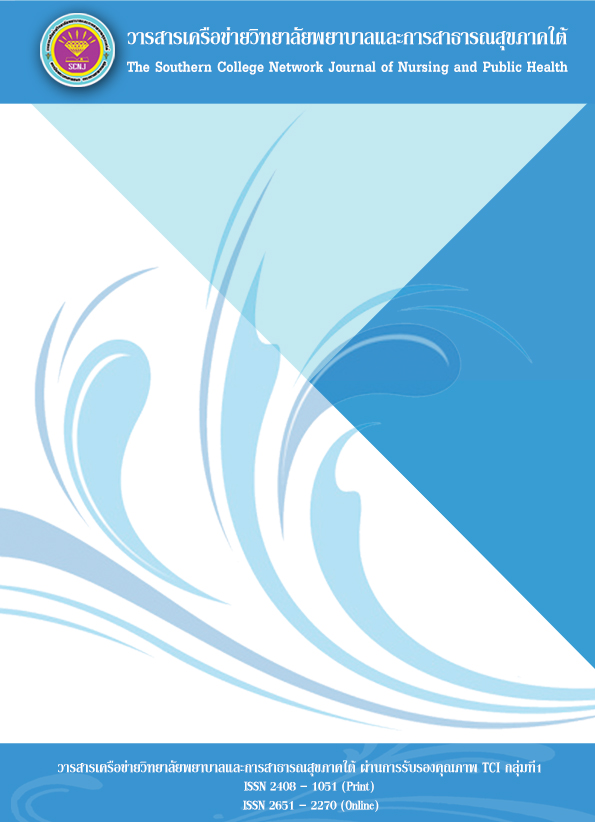การประเมินระดับไขมันในเลือด และปัจจัยที่มีความสัมพันธ์กับอัตรา TC/HDL-C ของผู้มีภาวะไขมันในเลือดผิดปกติในอำเภอเมือง จังหวัดตรัง
คำสำคัญ:
ระดับไขมัน, TC/HDL-C, อัตราไขมัน, ความรู้, ทัศนคติ, พฤติกรรมการบริโภคอาหารบทคัดย่อ
การศึกษาภาคตัดขวางนี้มีวัตถุประสงค์เพื่อประเมินระดับไขมันในเลือดของผู้ที่มีระดับไขมันผิดปกติและเพื่อศึกษาปัจจัยที่มีความสัมพันธ์กับอัตราโคเลสเตอรอลรวม (TC) ต่อ HDL-C (TC/HDL-C) ของผู้ที่มีระดับไขมันผิดปกติในเขตอำเภอเมือง จังหวัดตรัง โดยกลุ่มตัวอย่างที่ทำการศึกษาคือผู้ที่มีระดับไขมันในเลือดผิดปกติทั้งสิ้น 393 คน เครื่องมือที่ใช้ในการเก็บข้อมูลได้แก่ แบบสอบถามในการเก็บข้อมูลทั่วไปรวมถึงระดับไขมัน และอีกส่วนเป็นแบบสอบถามเรื่องความรู้ ทัศคติและพฤติกรรมการบริโภคอาหาร สถิติที่ใช้ในการวิเคราะห์ข้อมูลคือ ความถี่ ร้อยละ และสมการถดถอยพหุโลจิสติกส์ ผลการวิจัยพบว่า
กลุ่มตัวอย่างส่วนใหญ่เป็นเพศหญิง (ร้อยละ 74.00) อายุเฉลี่ย 64.63 ปี (SD=12.01) อยู่ในสถานภาพสมรส (ร้อยละ 66.20) และมากกว่าครึ่งหนึ่งมีค่าดัชนีมวลกายปกติ (ร้อยละ58.00) ส่วนระดับไขมันเดี่ยว คือ LDL-C และ Total Cholesterol (TC) อยู่ในระดับก้ำกึ่งถึงสูงเป็นส่วนใหญ่ (ร้อยละ 90.58 และ 88.55 ตามลำดับ) แต่ระดับ HDL-C โดยส่วนใหญ่อยู่ในระดับปกติ นอกจากนี้ค่าอัตราไขมันที่มีค่าเกินกว่าปกติโดยมีจำนวนมากกว่าครึ่งหนึ่งของกลุ่มตัวอย่างคือค่าอัตรา TC/HDL-C (ร้อยละ 50.90) ส่วนค่าอัตราไขมันที่มีระดับสูงรองลงมาคือ ค่า LDL-C /HDL-C และ TG /HDL-C ซึ่งมีสัดส่วนน้อยกว่าร้อยละ 50 ของกลุ่มตัวอย่าง และเมื่อพิจารณาในกลุ่มผู้ที่มีความรู้ ทัศคติและพฤติกรรมการบริโภคอาหารในระดับดี พบว่ามีค่าอัตรา TC/HDL-C อยู่ในระดับปกติมากกว่าครึ่งหนึ่งในกลุ่มผู้ที่มีความรู้ในระดับดี ส่วนในกลุ่มอื่นจะมีค่าปกติในสัดส่วนที่ต่ำกว่า สำหรับปัจจัยที่มีความสัมพันธ์กับอัตรา TC/HDL-C คือ เพศหญิง (OR = 2.46, p-value = 0.01) และความรู้ในการบริโภคอาหาร (OR = 0.58, p-value = 0.02) ซึ่งเป็นปัจจัยป้องกัน
ควรจะต้องมีการปรับวิธีการให้ความรู้ เพิ่มเติมความรู้ในด้านอื่นๆ เนื่องจากเป็นปัจจัยป้องกันที่อาจส่งผลต่อระดับไขมันในเลือดโดยเฉพาะในกลุ่มเพศหญิงและการติดตามผลในอนาคตเพื่อให้เกิดการเปลี่ยนแปลงพฤติกรรมและค่าระดับไขมันที่ดีขึ้น
เอกสารอ้างอิง
Anand, S. S., Yusuf, S., Jacobs, R., Davis, A. D., Yi, Q., Gerstein, H., et al. (2001). Risk Factors, Atherosclerosis, and Cardiovascular Disease among Aboriginal People in Canada: the Study of Health Assessment and Risk Evaluation in Aboriginal Peoples (SHARE-AP). Lancet, 6;358(9288): 1147-53.
Anand, S. S., Yusuf, S., Vuksan, V., Devanesen, S., Teo, K. K., Montague, P. A., et al. (2000). Differences in Risk Factors, Atherosclerosis, and Cardiovascular Disease Between Ethnic Groups in Canada: the Study of Health Assessment and Risk in Ethnic Groups (SHARE). Lancet, Jul 22;356(9226): 279-84.
Bloom, B. S., Madaus, G. F., & Hastings, J. T. (1971). Handbook on Formative and Summative Evaluation of Student Learning. New York: McGraw-Hill.
Boonsuk, S. (2010). Knowledge, Attitude and Practice of Lipid Consumption in Patients at 7th. Health Center of Ubonratchatanee Province, Research Report: Health Promoting Hospital of 7th Health Center of Ubonratchatanee. (in Thai).
Bureau of Non Communicable Diseases, Department of Disease Control, Ministry of Public Health, (2016). Annual Report 2016. Nonthaburi. The War Veterans Organization of Thailand. (in Thai)
Castelli, W. P. (1998). Cholesterol and Lipids in the Risk of Coronary Artery Disease-the Framingham Heart Study. The Canadian Journal of Cardiology, 4Suppl(A), 5a-10a.
Da Luz, P. L., Favarato, D., Faria-Neto, J. R., Lemos, P., & Chagas, A. C. (2008). High Ratio of Triglyceride to HDL-Cholesterol Predicts Extensive Coronary Disease. Clinics, 63, 427-432.
Executive Summary of The Third Report of The National Cholesterol Education Program (NCEP) (2001). Expert Panel on Detection, Evaluation, And Treatment of High Blood Cholesterol In Adults (Adult Treatment Panel III). Jama, 16(19), 2486-97.
Foosuwan, S., Lirtmunlikaporn, S., & Singkaew, J. (2016). Factors Predicting Serum Lipid Level among Persons with Dyslipidemia in Community. Nursing Journal, 42(2), 79-89. (in Thai)
Gaziano, J. M., Hennekens, C. H., O’Donnell, C. J., Breslow, J. L., & Buring, J. E. (1997). Fasting Triglycerides, High Density Lipoprotein, and Risk of Myocardial Infarction. Circulation, 96, 2520-2525.
Grundy, S. M., Cleeman, J. I., Merz, C. N., Brewer, H. B. Jr., Clark, L. T., Hunninghake, D. B., et al. (2004). National Heart, Lung, and Blood Institute, American College of Cardiology Foundation, American Heart Association: Implication of Recent Clinical Trials for the National Cholesterol Education Program Adult Treatment Panel III Guidelines. Circulation, 110, 227-239.
Lee, J. S., Cheong, H. S., & Shin, H. D. (2018). Prediction of Cholesterol Ratios within a Korean Population. Royal Society Open Science, 5(1),171-204.
McGovern, P. G., Pankow, J. S., Shahar, E., Doliszny, K. M., Folsom, A. R., Blackburn, H., et al. (1996). Recent Trends in Acute Coronary Heart Disease--Mortality, Morbidity, Medical Care, and Risk Factors. The Minnesota Heart Survey Investigators. The New England journal of medicine, 334(14), 884-90.
Mirmiran, P., Mohammadi-Nasrabadi, F., Omidvar, N., Hosseini-Esfahani, F., Hamayeli-Mehrabani, H., Mehrabi, Y. et al. (2010). Nutritional Knowledge, Attitude and Practice of Teharanian Adults and TheirnRelation to Serum Lipid and Lipoproteins: Teharan Lipid and Glucose Study. Annals of Nutrition & Metabolism, 56(3), 233-40.
Nijjar, A. P., Wang, H., Quan, H., & Khan, N. A. (2010). Ethnic and Sex Differences in the Incidence of Hospitalized Acute Myocardial Infarction: British Columbia, Canada 1995-2002. BMC Cardiovascular Disorders, 19(10), 38.
Phupolpian, T. (2018). Knowledge, Attitude and Food Consumption Behavior of People with Dyslipidemia in Amphoe Mueangtrang Changwat Trang. A Specific Health Study Submitted in Partial Fulfillment of the Requirement for the Bachelor Degree in Public Health (Community Public Health). Department of Community Public Health, Sirindhorn College of Public Health, Trang. (in Thai)
Stampfer, M. J., Sacks, F. M., Salvini, S., Willett, W. C., & Henneckens, C. H. (1991). A Prospective Study of Cholesterol Apolipoproteins and the Risk of Myocardial Infarction. New Eng J Med, 325, 373-381.
Sheth, T., Nair, C., Nargundkar, M., Anand, S., & Yusuf, S. (1999). Cardiovascular and Cancer Mortality among Canadians of European, South Asian and Chinese Origin from 1979 to 1993: An Analysis of 1.2 Million Deaths. CMAJ : Canadian Medical Association journal, 161(2), 132-8.
Trang Provincial Public health Office. (2017). Report of Prevalecnce of NCDs. Retrived December 3, 2018 from: http://www.tro.moph.go.th. (in Thai)
Wilkins, R., Tjepkema, M., Mustard, C., & Choiniere, R. (2008). The Canadian Census Mortality Follow-Up Study, 1991 through 2001. Health reports, 19(3), 25-43.
Yamane, T. (1967). Statistics: An Introductory Analysis. 2nd, editor. New York: Harper & Row.
Zhang, L., Chen, S., Deng, A., Liu, X., Liang, Y., Shao, X., et al. (2015). Association Between Lipid Ratios and Insulin Resistance in a Chinese Population. PloS one, 10(1), e0116110-e.
Zhou, M., Zhu, L., Cui, X., Feng, L., Zhao, X., He, S., et al. (2016). The Triglyceride to High-Density Lipoprotein Cholesterol (TG/HDL-C) Ratio as a Predictor of Insulin Resistance but not of β Cell Function in a Chinese Population with Different Glucose Tolerance Status. Lipids in Health and Disease, 15, 104.
ดาวน์โหลด
เผยแพร่แล้ว
ฉบับ
ประเภทบทความ
สัญญาอนุญาต
1. บทความหรือข้อคิดเห็นใด ๆ ที่ปรากฏในวารสารเครือข่าย วิทยาลัยพยาบาลและการสาธารณสุขภาคใต้ ที่เป็นวรรณกรรมของผู้เขียน บรรณาธิการหรือเครือข่ายวิทยาลัยพยาบาลและวิทยาลัยการสาธารณสุขภาคใต้ ไม่จำเป็นต้องเห็นด้วย
2. บทความที่ได้รับการตีพิมพ์ถือเป็นลิขสิทธิ์ของ วารสารเครือข่ายวิทยาลัยพยาบาลและการสาธารณสุขภาคใต้








